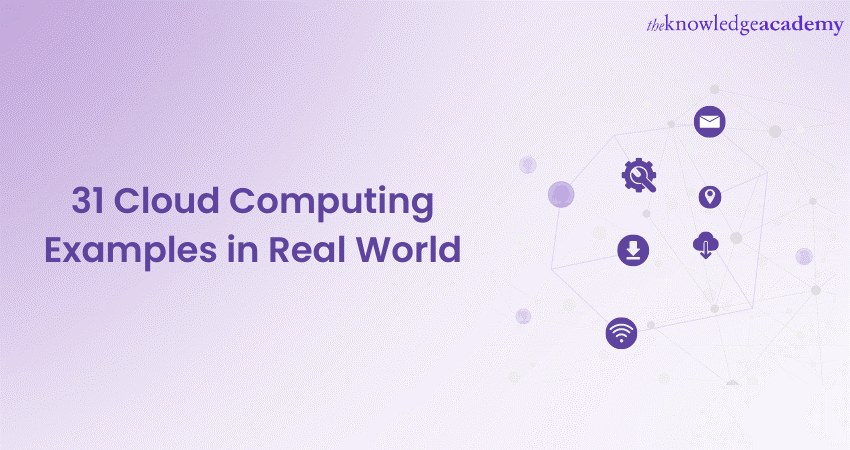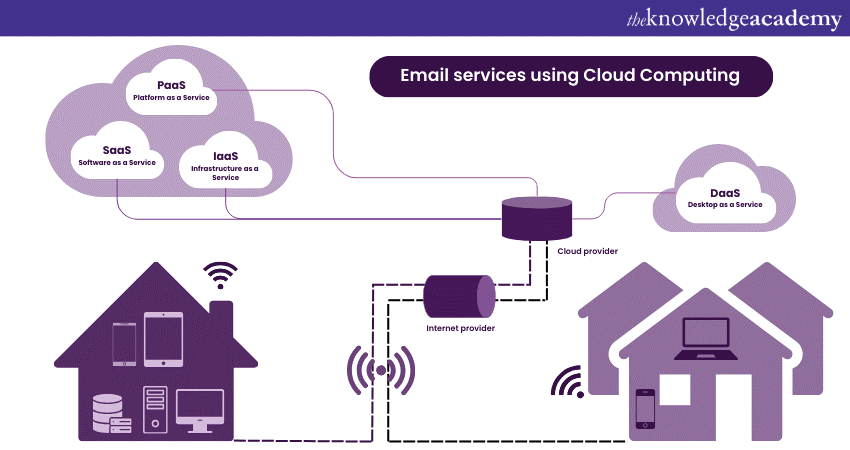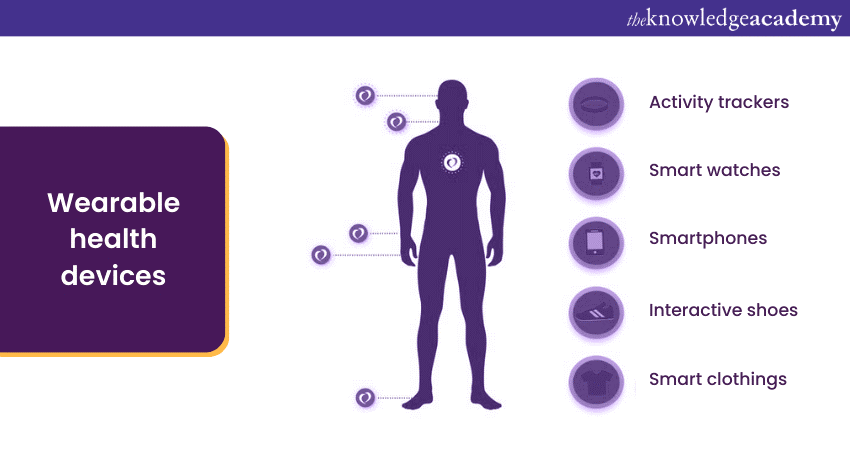We may not have the course you’re looking for. If you enquire or give us a call on 01344203999 and speak to our training experts, we may still be able to help with your training requirements.
Training Outcomes Within Your Budget!
We ensure quality, budget-alignment, and timely delivery by our expert instructors.

In today's digitally driven world, we see many Cloud Computing Examples. Cloud Computing has revolutionised the manner in which we interact with technology daily. It has changed the landscape of businesses and personal computing alike. Moreover, it has emerged as a driving force behind innovation and efficiency. Want to know how? Read this blog to explore 31 Cloud Computing Examples and learn how Cloud Computing provide solutions by reshaping the way businesses operate and people live.
Table of Contents
1) What is Cloud Computing?
2) Common Cloud Computing Examples
3) Cloud Computing Examples in business
4) Health and research examples of Cloud Computing
5) Cloud Computing Examples in entertainment and media
6) Miscellaneous Cloud Computing Examples
7) Conclusion
What is Cloud Computing?
Cloud Computing is an internet-based technology. It delivers various computing services. These include storage, databases, servers, networking, and software. Users access these services over the internet. The goal is to provide scalable and efficient computing resources. Users often pay only for the services they use. This reduces costs and increases flexibility. Traditional local servers are often replaced by cloud services. As a result, businesses can work more flexibly and scale operations efficiently.
Join our Linux OpenStack Administration Training and elevate your cloud computing skills!
Common Cloud Computing Examples
From the emails we send to the memories we cherish, the cloud stands as an invisible guardian, storing, backing, and synchronising. Here, we'll delve into seven key ways the cloud touches our personal lives, making tasks easier, memories safer, and everyday activities more streamlined:
a) Email services: Platforms like Gmail and Yahoo Mail revolutionised communication. They store emails on cloud servers. This means you can access your messages from any device. From home or travelling, your emails are just a click away. The following image shows how email services use Cloud Computing:

b) Photo storage: Preserving memories is vital. Services like Google Photos and iCloud have made this task easier. By storing pictures in the cloud, users can access them anywhere. Even if you have lost your phone, your photos remain safe and intact in the cloud storage.
c) Document collaboration: Working on documents is no longer a solo task. Cloud Computing Tools like Google Docs and Microsoft OneDrive have changed the game. Multiple users can edit in real time.The cloud ensures seamless collaboration and updates, fostering productivity.
d) Cloud backup: Ever lost important files? It's a nightmare. Dropbox and similar services prevent such mishaps. They back up your files to the cloud. From a document, photo, or video, they get secured, and the access is available across all your devices.
e) Cloud-based calendars: Missed an appointment? Cloud-based calendars like Google Calendar or Apple’s iCal have you covered. They sync across devices, sending reminders and alerts. You can also share events and schedules. Therefore, life can get a bit more organised.
f) Personal finance: Managing money requires meticulousness. Apps like Mint use the cloud to keep track. So, connect your bank accounts and bills as they provide insights into spending patterns. Budgeting becomes more intuitive and transparent.
g) Fitness and health tracking: Staying fit is a modern mantra. Apps like MyFitnessPal or Fitbit sync your health data to the cloud. Track your meals, workouts, and sleep patterns. Set goals and monitor progress. All data is accessible, making health management a breeze.
Cloud Computing Examples in business
The corporate has seen a profound transformation with the advent of Cloud Computing. Operations are more efficient, data storage is safer, and collaboration knows no geographical boundaries. Let's see how Cloud Computing Applications have reshaped modern businesses:
a) Customer Relationship Management (CRM): Salesforce, a leading CRM tool, harnesses the cloud. It helps businesses manage customer interactions. Information is centralised and accessible. Moreover, teams can track leads, sales, and customer feedback efficiently, promoting better decision-making.
b) Enterprise Resource Planning (ERP): ERP systems, like SAP, are cloud game-changers. They integrate various business processes. From finance, HR, to procurement, data is synchronised. Businesses benefit from real-time insights and streamline operations.
c) E-commerce Platforms Amazon Web Services (AWS): It exemplifies cloud power in e-commerce. It provides robust infrastructure for online shops. As a result, these platforms handle massive traffic and transactions. Customers experience seamless shopping, while businesses scale effortlessly.

d) Human resources management: Tools like Workday have revolutionised HR. From recruitment to payroll, everything processes in the cloud. Employee data is centralised, and onboarding is streamlined. Thus, HR teams can focus on strategy over manual tasks.
e) Project management: Trello and Asana are popular cloud-based tools. They facilitate team collaboration on projects. Tasks, deadlines, and communications are clear. Teams, whether in-office or remote, work cohesively towards goals.
f) Data analytics and business intelligence: Platforms like Tableau and Power BI leverage the cloud. They process vast data sets. Businesses get valuable insights from visualised data. Decision-making becomes data-driven, fostering growth and innovation.
g) Supply chain management: Cloud solutions optimise supply chains. Platforms like Oracle SCM Cloud offer real-time tracking. Moreover, inventory, logistics, and procurement are integrated. This ensures timely deliveries and reduces operational costs.
Unlock the power of the cloud computing with our Cloud Computing Course – Register today!
Health and research examples of Cloud Computing
Electronic Health Records (EHR) Digital patient data has revolutionised healthcare. Epic and similar systems centralise this vital information. Any authorised healthcare professional can retrieve it. This ensures consistent, knowledgeable care across various medical touchpoints.
a) Medical image analysis: Storing vast medical images was once challenging. Today, cloud storage solutions cater to this need. Radiologists no longer wait for physical film. Digital scans are accessible instantly. Analysis and sharing become more efficient, improving patient diagnostics.
b) Genomic research: Genomic data is vast and complex, and storing this on traditional systems was impractical. With the cloud, researchers can save, retrieve, and analyse vast genomic sequences. It speeds up research, heralding a new era in personalised medicine.
c) Collaborative medical research: Research often requires multiple minds. Cloud platforms foster this collaboration, they break geographical barriers, uniting experts globally. Shared databases and tools facilitate faster discoveries, benefiting worldwide health initiatives.
d) Telemedicine services: Physical presence isn't always feasible or needed. Telemedicine, powered by cloud platforms like Teladoc, bridges this gap. Secure video consultations are scheduled. Doctors offer guidance, prescribe medication, and more without physical appointments.
e) Clinical trial management: Conducting clinical trials demands meticulous data management. Solutions like Medidata leverage the cloud for this purpose. Every patient's data, trial phase, and observation are systematically logged. It ensures accuracy, speeding up the trial process.
f) Wearable health devices: Today's wearables are more than fashion. Devices like Fitbit gather health data continuously. Steps, heart rate, sleep cycles - all get synced to the cloud. Users and health professionals can analyse this data, leading to informed health decisions. These devices include the following:

g) Electronic Health Records (EHR): Digital patient data has revolutionised healthcare. Epic and similar systems centralise this vital information. Any authorised healthcare professional can retrieve it. This ensures consistent, knowledgeable care across various medical touchpoints.
Cloud Computing Examples in entertainment and media
Entertainment and media have drastically transformed with the advent of Cloud Computing. Today, it's easier than ever to create, share, store, and consume content, thanks to the omnipresent cloud. As we immerse ourselves in the vibrant world of media and entertainment, let's delve into seven standout examples of how Cloud Computing shapes our experiences.
a) Streaming services: Netflix, Spotify, and Disney+ have become household names. The cloud powers these streaming giants. Content is hosted on vast cloud servers, making on-demand streaming a reality. From catching the latest movie or grooving to a chart-topper, the cloud ensures smooth, buffer-free experiences. The scalability it offers also allows these platforms to cater to millions simultaneously.
b) Game streaming platforms: Gaming has evolved with platforms like Google Stadia. No need for high-end consoles or PCs. The cloud handles game processing. Players simply stream high-quality gameplay on their devices. This means access to high-end gaming experiences without investing in expensive hardware, and it's all thanks to the cloud's immense processing capabilities.
c) Digital publishing: Authors and publishers are turning to platforms like Amazon Kindle Direct Publishing. With the cloud, they upload manuscripts, design covers, and distribute them globally. Readers, in turn, download e-books in seconds. The traditional barriers of publishing crumble, granting authors a direct line to their audience.
d) Video editing and production: Software like Adobe Creative Cloud have revolutionised video production. Editors access tools and files anywhere, anytime. Collaboration on projects becomes seamless. Instead of transferring massive files, editors work in sync through the cloud. It streamlines workflows, enabling faster content creation and delivery.
Miscellaneous Cloud Computing Examples
The influence of Cloud Computing isn't confined to just mainstream sectors. Its reach extends into unexpected corners of our daily lives, often enhancing tasks and experiences in subtle yet profound ways. Let's venture into three intriguing examples where the cloud is making an unexpected impact:
a) Agriculture and farming: The age-old sector of agriculture has met with the Future of Cloud Computing. Precision agriculture tools, which leverage cloud data, help farmers make informed decisions. Sensors monitor soil conditions, weather predictions, and crop health. All this data is sent to the cloud, and algorithms analyse it, offering insights. This results in optimised irrigation, planting, and harvesting. Thus, farms become more sustainable and productive, ensuring food security for growing populations.
b) Smart cities: The concept of smart cities is rooted in efficient urban planning using tech. Cloud platforms collect data from traffic signals, waste management systems, and energy grids. This data is processed in real time. Insights direct traffic flow, optimise energy consumption and ensure timely waste collection. As a result, cities become more liveable, with reduced congestion and enhanced public services. The cloud, thereby, paves the way for sustainable urban living.
c) Retail and customer: The shopping experience has evolved with the cloud, both in-store and online retailer's benefit. Sensors track inventory and customer preferences in real time. This data is sent to the cloud. Algorithms analyse purchasing patterns, predicting future trends. Retailers get insights on stock levels and customer preferences. Shoppers, on the other hand, receive personalised recommendations. It elevates the shopping experience, ensuring customers find what they desire and retailers optimise sales.
Conclusion
Embracing the future means understanding and integrating the numerous Cloud Computing Examples around us. By leveraging shared resources in cloud data centres, we reduce the carbon footprint. Instead of every organisation maintaining its own data centre, shared cloud resources optimise energy usage. It's a paradigm shift, accommodating the demands of modern businesses and individuals.
Dive into the future of scalable software with Microservices Architecture Training – Register today!
Frequently Asked Questions
Upcoming Cloud Computing Resources Batches & Dates
Date
 Cloud Computing Training
Cloud Computing Training
Thu 15th Aug 2024
Thu 5th Dec 2024







 Top Rated Course
Top Rated Course


 If you wish to make any changes to your course, please
If you wish to make any changes to your course, please


